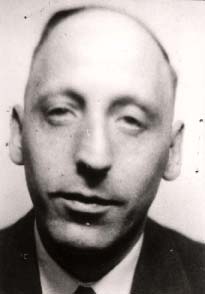Search for Names, Places and Biographies
Already layed Stumbling Stones
Suche
James Tannenberg * 1891
Dillstraße 15 (Eimsbüttel, Rotherbaum)
1941 Minsk
further stumbling stones in Dillstraße 15:
Gustav Gabriel Cohn, Siegbert Stephan Frankenthal, Pauline Frankenthal, Lothar Frankenthal, Judith Moritz, Margot Moritz, Siegmund Nissensohn, Aron Julius Rosemann, Werner Streim, Dr. Siegfried Streim, Sulamith Streim, Johanna Streim, Kurt Salo Streim, Senta Tannenberg
James Tannenberg, born on 6 Oct. 1891, deported to Minsk on 8 Nov. 1941
Senta Tannenberg, born on 5 Nov. 1896, deported to Minsk on 8 Nov. 1941
Dillstrasse 15
James Tannenberg, by profession a sales representative, was born on 6 Oct. 1891 in Altona. His somewhat younger wife Senta, née Horwitz, was born on 5 Nov. 1896. The last known joint address of the Tannenberg couple was Dillstrasse 15 in Hamburg’s Eimsbüttel District.
Senta Tannenberg grew up as the middle of four siblings with her mother Johanna Horwitz, née Tannenberg, and her father, Heimann Horwitz. Her younger siblings were named Henny, Mathilde, James, and Paula.
The married couple James and Senta Tannenberg was deported to the Minsk Ghetto on 8 Nov. 1941. Apart from this event and the date of death, no further details concerning Senta’s life have been found.
James Tannenberg had grown up with his parents Franziska Tannenberg, née Cohn, his father Albert Tannenberg, and his twin sister Irma, later married name Dublon. Nothing is known about his childhood and youth.
As an adult, James Tannenberg worked as a purchaser for the Karstadt Department Store on Mönckebergstrasse in Hamburg. Under pressure from the Nazi regime, the department store dismissed all Jewish employees without notice in 1933, including James Tannenberg.
In 1934, Irma Dublon’s husband Leopold, James Tannenberg’s brother-in-law, passed away. Irma Dublon continued his commercial agency. On 1 Jan. 1936, she took James Tannenberg into the company as a partner, where he worked until the business was liquidated.
During the November Pogrom in 1938, James Tannenberg was imprisoned in the Sachsenhausen concentration camp. When he was released and returned to Hamburg is not known.
The "Leopold Dublon & Co.” company, too, was forcibly "Aryanized” or liquidated, like all Jewish businesses. On 2 Aug. 1940, it was liquidated and deleted from the company register.
Nothing is known either about the lives of James and Senta Tannenberg between the company’s liquidation and their deportation to the Minsk Ghetto on 8 Nov. 1941. The train arrived there on 11 Nov. 1941. According to the testimony of Hermann Mark Lissauer, Senta and James Tannenberg’s nephew, both were allegedly shot dead in Minsk on 29 June 1942. There is no further evidence for this.
Some of Senta and James Tannenberg’s relatives were able to save themselves and their children. The aforementioned nephew, Hermann Mark Lissauer, son of Senta Tannenberg’s sister Paula, married name Lissauer, survived the Westerbork transit camp and the Bergen-Belsen concentration camp with his mother. His father and brother had fled in time via Britain to Australia. In 1946, the family was able to reunite there. Hermann Mark Lissauer lived in Melbourne until his death on 28 Feb. 2016. He had Stolpersteine set in Hamburg for several murdered relatives, including James and Senta Tannenberg.
Irma Dublon’s marriage produced Ilse Jaqueline Jackson and Kenneth Kurt Michael Dublon; Kenneth Dublon has a son named Alan Dublon. The last known address of Kenneth Dublon in 1958 was London N14.
The descendants of an aunt of James Tannenberg, Alice and Iwan Cleve, are said to live in Buenos Aires and San Francisco today. However, even the research done by Ilse and Kenneth Dublon could not determine their exact whereabouts.
Translator: Erwin Fink
Kindly supported by the Hermann Reemtsma Stiftung, Hamburg.
Stand: September 2020
© Jana Neumann
Quellen: 1; 4; 8; StaH 351-11, AfW, 13205 Tannenberg, James; Petra Rentrop-Koch (2017). Die "Sonderghettos" für deutsche Jüdinnen und Juden im besetzen Minsk (1941- 1943). In: Beate Meyer (Hg.), Deutsche Jüdinnen und Juden in Ghettos und Lagern (1941- 1945) Lodz. Chelmno, Minsk. Riga, Auschwitz. Theresienstadt, Berlin/Hamburg 2017, S. 88- 109; Ursula Wamser/Wilfried Weinke, Von Hamburg nach Melbourne: Hermann Mark Lissauer; Hermann Mark Lissauer: Mein Geburtshaus stand in der Grindelallee 116, beide in: dies., (Hg.), Eine verschwundene Welt. Jüdisches Leben am Grindel, Springe 2006, S.30-32 u. S. 33-35.
Zur Nummerierung häufig genutzter Quellen siehe Link "Recherche und Quellen".


